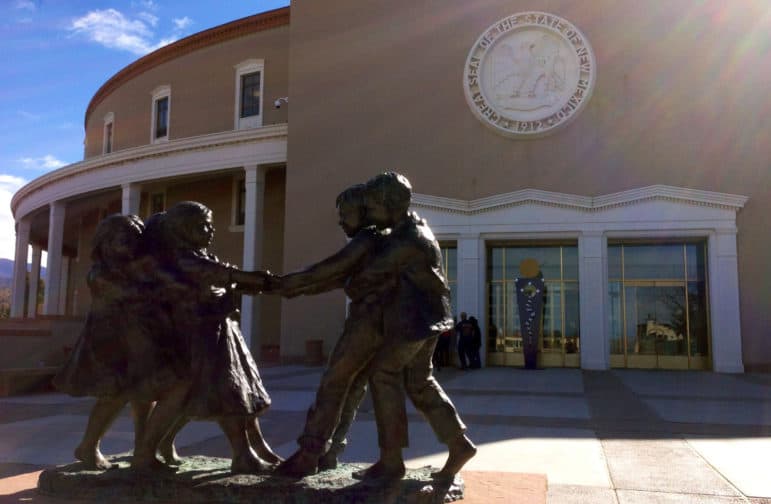
Heath Haussamen / NMPolitics.net
A statue outside the Roundhouse in Santa Fe.
New Mexico legislators start their 60-day session Tuesday with plenty of unfinished business, including closing a projected budget deficit of about $67 million.
But any hope that the passing of a rancorous election year and the ongoing budget crisis would inspire bipartisan compromise already seems to have evaporated.
Instead, Republican Gov. Susana Martinez and top lawmakers have staked out positions that almost guarantee a clash over taxes and spending. In addition, more budget cuts are likely, no matter the outcome.
Martinez proposed easing the projected deficit by requiring public employees to pay for a bigger share toward their pensions. The governor’s budget chief says the move would save the state about $100 million each year and avoid layoffs and furloughs. Labor unions counter that the proposal amounts to a pay cut for tens of thousands of families.
The governor also has suggested taking $125 million from the savings accounts of public school districts. While the state Senate approved siphoning off a smaller amount during the fall special session intended to address the very budget problems lawmakers are facing yet again, members of the House of Representatives blocked the move. School districts had staunchly opposed the idea of losing their emergency accounts.
The governor said the savings amounted to a “slush fund” for school district bureaucracy and pointed out that the state has tapped the reserves before during tight times. But administrators and teachers unions say the reserves provide financial stability for public schools.
Speaking to reporters in Albuquerque one recent day, Martinez was quick to blame the deficit on legislators.
“Difficult decisions were avoided during an election year,” she said.
The governor signed a $6.2 billion budget last February that cut spending by 2 percent for most state agencies, and it made even larger reductions for colleges and universities. With the decline of oil and gas prices, as well as the collapse of drilling operations around the state, driving down state revenues, the budget was the leanest since 2009.
The state’s financial situation only worsened as oil prices continued to slide. Legislators returned to the Capitol at the end of September to pay off a deficit from the previous year totaling more than $200 million by making more cuts.
Even so, those reductions did not solve the financial crisis, prompting some Democrats to say tax increases also would have to be considered. But Martinez repeated her opposition to raising taxes, even if some measures have bipartisan support.
Leading legislators fired back, accusing the Republican governor of placing extra burdens on workers and students.
“We can’t cut our way out of this recession,” said Sen. Howie Morales, D-Silver City. He described the governor’s pension proposal as “inhumane.”
The Legislative Finance Committee recommended closing the budget deficit in part with a smaller raid on school district reserves, delaying funding for public works projects and diverting money from an existing cigarette tax earmarked to cover the cost of a university building that is nearly paid off.
For the budget year that begins in July, both the finance committee and governor proposed lean budgets that would cut funding for many state agencies and universities.
The price of oil is rising, buoying hopes for the state’s revenues, but New Mexico’s government is still expected to bring in close to $100 million less than it did this year, according to the Legislative Finance Committee.
Both budgets would increase funding for the Corrections Department and leave largely untouched the overall budgets of the Children, Youth and Families Department and the Department of Cultural Affairs.
The Legislative Finance Committee’s budget would total $6.05 billion and boost funding for the state’s court system as well as the Law Offices of the Public Defender. Both arms of government had requested bigger increases in funding. The state public defender even declined to take new clients in Hobbs because defense attorneys were already overloaded with cases. The governor’s budget, totaling about $6.09 billion, would leave funding for the agency flat.
But the committee’s budget would cut funding for education by about $27.4 million, or eight-tenths of a percent. Meanwhile, the governor touted her budget because it would not siphon money from the stream of funding the state provides to school districts. And the committee’s budget relies on lawmakers approving a tax on health care services as well as finding an additional $123 million in new taxes or additional cuts.
A spokesman for the governor blasted the committee’s proposed budget.
“The governor believes it’s up to state government to tighten its own belt — not our hardworking families,” Mike Lonergan said in an email. “Her plan doesn’t raise taxes and it protects classroom spending, economic development efforts and public safety.”
The criticism from Martinez’s camp casts doubt on the prospects for bipartisan agreement on tax reform. Legislators from both parties have voiced support in recent months for at least a few new revenue measures. One idea is collecting gross receipts tax from online retailers such as Amazon. Republicans have argued the move would support hometown businesses competing with major corporations. But Martinez said she would not sign the bill if it’s approved, signaling that more cutbacks are likely.
Contact Andrew Oxford at (505) 986-3093 or aoxford@sfnewmexican.com. Follow him on Twitter @andrewboxford.